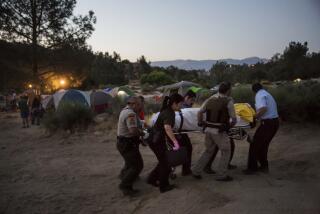Parents Lax on Safety Around the Water Pay Dearly, Experts Warn
- Share via
Orange County, with its warm weather and affluent neighborhoods, can be deadly for little children.
“Each year there are 10 to 12 children who die in Orange County in drowning accidents,” according to Dr. Ralph Rucker, director of the pulmonary division of Childrens Hospital of Orange County. “Orange County has the highest or close to the highest rate (of deaths) in the country.”
Rucker termed it the “lethal luxury of back-yard pools. People don’t think of that when they put in pools.”
The drowning rate is “repulsively consistent,” said Rucker, who is on the advisory board of the Orange County Trauma Society, which operates the “Protect Our Kids” drowning prevention program for children.
People More aware
It seems as if “the numbers of pool drownings have not changed dramatically,” he said. “However . . . we seem to have made more people aware, . . . judging from individual comments and pool-supply people and trauma society.”
But Dollie Brill of Newport Beach, co-chairwoman of Protect Our Kids, said Thursday night that she fears that 1989 will “be a disastrous year” for drownings or near-drownings of children in county pools.
“The public seemed to learn when the news media a few years ago took interest in this problem,” Brill said. “But in recent years the media has not been paying attention.”
Brill, whose own daughter almost drowned in a pool accident 10 years ago, said she has been working since then to alert parents to the dangers of pools and spas for young children.
‘Epidemic’ of Drownings
Nonetheless, she said, California “has had an epidemic” of children drowning in pools and spas in the late 1980s. She said 103 children drowned in the state in 1985, 13 from Orange County; 123 statewide in 1986, 18 from the county, and 140 in 1987, 11 from the county.
Brill, who is president of the National Drowning Network, said California child-drowning figures for 1988 are not yet available.
She added that she thinks 1989 already shows signs of increased drownings or near-drownings statewide.
Rucker, commenting on Thursday’s incidents in North Tustin, said: “It is quite early in the year to have that kind of accident happen. Usually the drowning season is from May to September, although in Orange County it occurs year-round.”
“It is a very big problem nationwide, but especially in areas like Orange County, . . . areas that are affluent and have good weather.”
The Trauma Society’s program educates preschool children about dangers of swimming pools, using puppet shows, coloring books and other presentations. The program also involves the swimming pool industry.
Nevertheless, at CHOC in Orange, which receives more cases of drownings and near-drownings than any other hospital in the county, 35 children were admitted last year. Four of them died.
“About 25% of the children in near-drowning accidents either die or, even worse, have severe brain injury,” Rucker said. “Drowning has assumed the somewhat dubious distinction of being the major cause of acquired retardation among children in California. It is one of the major causes for admission for California’s system for long-term care for brain-injured children . . . such as Lanterman Hospital in Pomona.
“Even in Orange County, with the long coastline and a lot of ocean, 90%-plus of drownings occur in the home pools. There aren’t any lifeguards.
“If you see 2-years-olds at the beach, there’s always somebody watching them, and they are scared of the (waves). That doesn’t happen at the home.
“There are between 100,000 and 200,000 pools and spas in Orange County, and you never get rid of one of them. You never see anyone pulling one out.
“Pools have to be treated like the busy street out in front or a hot flame. You have to have a respect for it. If you don’t have that respect, you run a danger.
“The best advice I can give a young couple . . . is to delay such purchase until their youngest (child) is 5 years old. The highest risk for these babies is 2 years old, and the risk drops off appreciably after 5.
“Develop an attitude of caution and concern regarding safety among all members of the family, and include the smaller children in that.”
Children should know the need for safety around a pool “so everybody in the family is aware of how dangerous these things are,” Rucker said.
“Very few children go next door and drown. They drown at home or at the grandparents’. The most important thing is constant adult supervision. The second most important thing is for that adult who is watching the children to know CPR,” he said, referring to cardiopulmonary resuscitation.
Enclosing a pool with a fence or covering it can help but is no guarantee of safety, he said.
“Almost all municipalities in Orange County have rules requiring fencing and gates to keep the little people out,” Rucker said. “But most of those do not include having fences that just surround the pools. They surround the house too. Those laws were apparently designed to protect the neighbors’ kids.
“A 2-year-old can go over most fences pretty quickly. We’ve had episodes of children drowning because they slip under a pool cover. . . . A well-constructed pool cover is valuable, but as a first line of defense, that is not your best defense. Total awareness is.”
As car seats and other restraints mandated by law have reduced automobile-related injuries to children, “drowning has assumed No. 1 importance in childhood injuries in the state,” Rucker said.
More to Read
Sign up for Essential California
The most important California stories and recommendations in your inbox every morning.
You may occasionally receive promotional content from the Los Angeles Times.













